
cmd enters the d drive by opening the command prompt, entering the command and verifying the switching steps. Detailed introduction: 1. Open the command prompt, press the Win key R, enter "cmd" in the run dialog box, and then click "OK" to open the command prompt window; 2. Enter the command, in the command prompt window, enter D: command and press the Enter key; 3. To verify the switch, enter the cd command and press the Enter key.

To enter the D drive from the command line of Windows system, you can follow the following steps:
1. Open the command prompt : Press the Win key R, enter "cmd" in the run dialog box, and then click "OK" to open the command prompt window.
2. Enter the command: In the command prompt window, enter the following command and press the Enter key:
D:
This will switch the current working directory to the root directory of the D drive.
3. Verify the switch: Enter the following command and press Enter:
cd
This will display the current working directory, make sure it is displayed as the root directory of the D drive.
Please note that the command prompt window may display the root directory of the system disk (usually the C drive) by default. By performing the above steps, you will switch to the D drive and execute commands in that directory.
In addition, if you want to enter a folder under the D drive, you can enter the corresponding folder path in step 2. For example, if you want to enter the folder named "Documents" under the D drive, you can use the following command:
D: cd Documents
This will switch to the "Documents" folder under the D drive.
The above is the detailed content of How to enter the d drive with cmd. For more information, please follow other related articles on the PHP Chinese website!




